Introduction
Green roofs are one type of Low Impact Development (LID) technique. LID is a sustainable approach to stormwater management that minimizes impacts on waterways by controlling rainfall and runoff close to the source. Also referred to as vegetated roofs, eco-roofs, roof gardens and living roofs, green roofs have been used for hundreds of years as a way of keeping houses cool in the summer and warm in the winter.
The use of green roofs is growing in the West. In addition to absorbing rainfall and snowmelt, they provide a number of other benefits. During the heat of summer, the surface temperature of a vegetated rooftop can be cooler than the air temperature, significantly reducing the urban “heat island” effect of conventional roofs. Green roofs also provide excellent insulation and can reduce indoor heating and cooling costs. They help filter air pollutants, provide increased wildlife habitat and urban green space, and are visually attractive.
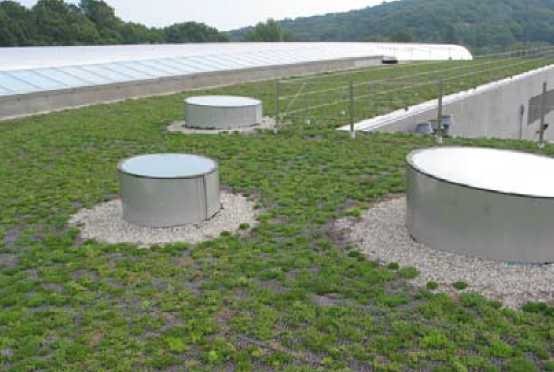
Image by Connecticut NEMO Program.
How does a green roof work?
A typical green roof consists of several inches of lightweight soil or other growth medium planted with specially selected vegetation, placed over a drainage layer and a waterproof membrane.
Green roofs help to decrease the amount of stormwater that runs off roofs by absorbing water like sponges. An average of 63 percent of the rainfall volume of most rainstorms can be retained in 2 to 6 inches of growth medium. The plants take up and transpire rainwater and help process pollutants such as nutrients. In addition to stormwater-management benefits, green roofs also help decrease energy costs by providing thermal mass and evaporational cooling. The layer of soil and plants is more resistant than conventional roofing materials to the damaging effects of ultraviolet light and temperature extremes, helping to prolong the life of the roof.
Benefits of Green Roofs
- ABSORB rainfall
- REDUCE urban runoff at the source
- IMPROVE runoff quality
- REDUCE the urban heat island effect
- ADD green, natural landscapes and wildlife habitat to dense urban areas
- PROVIDE building insulation
- REDUCE noise pollution
- INCREASE roof lifespan
For a description of various Low Impact Development practices
Consult the following Fact Sheets in the “Low Impact Development in Northern Nevada” series:
- LID: An Introduction, FS-09-22
- Soil Considerations, FS-09-23
- Rainwater Harvesting, FS-09-24
- Bioretention, FS-09-25
- Vegetated Swales and Buffers, FS-09-26
- Green Roofs, FS-09-27
- Plant Materials, FS-09-28
- Porous Pavement, FS-09-29
- Roadway and Parking Lot Design, FS-09-30
- Maintenance, FS-09-31
Types of green roofs
There are two structural types of green roofs: extensive and intensive. Extensive green roofs are typically installed on roofs with slopes of less than 25 percent. They are relatively lightweight and are planted with hardy, drought-tolerant plants such as sedums, succulents or hardy perennials. This keeps irrigation needs and costs relatively low, although some irrigation will be needed during initial plant establishment and occasionally during hot and dry periods. It is important to monitor plant health and adjust irrigation accordingly. Extensive roofs generally incorporate about 2 to 6 inches of lightweight growth media. The media must be low in organic matter content to avoid settling, leaching of nutrients and rapid plant growth.
Extensive green roofs are low-maintenance and usually do not provide public access. Depending on the age and type of the structure, roof reinforcement to handle the extra weight of an extensive green roof may not be needed, making them potentially suitable for retrofit projects. Consult an architect and/or structural engineer whenever considering the retrofit of a green roof onto an existing roof.
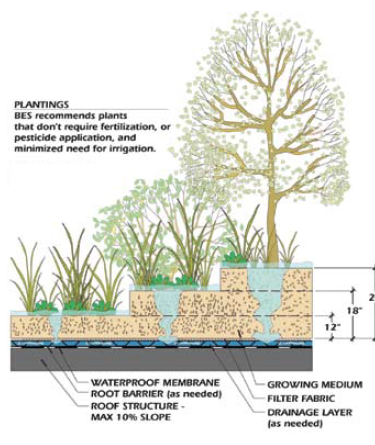
Elements of an intensive green roof. Image by Portland Bureau of Environmental Services (BES).
Intensive green roofs typically include 12 inches or more of soil or growth medium and may incorporate lawns or trees. They require extra structural support, as they are designed to create usable outdoor garden spaces. Some hospitals and other public facilities add green roofs as forms of healing or nature gardens.
They can retain more stormwater and provide more insulation and energy efficiency than extensive roofs. However, the cost is higher for intensive roofs, as there are additional structural and irrigation requirements. The addition of a waterproof membrane, a drainage layer, growth medium and plants adds weight to the roof. On average, each square foot of green roof, when saturated during a storm, will add 10 to 25 pounds. The load can be incorporated when designing new buildings, but may require additional measures when retrofitting onto existing buildings.
To reduce the potential for structural problems and leaks, hire experienced engineers and contractors to design and install extensive and intensive green roofs.
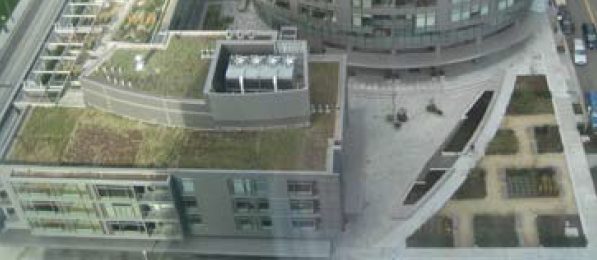
This building in Portland, Oregon, has both extensive (left) and intensive (right) green roofs. Image by Chris Conway.
Are green roofs expensive?
The initial costs for engineering and installing a green roof average about $10 to $15 per square foot for new construction, and $15 to $25 per square foot for re-roofing, which is considerably higher than the cost of a conventional roof. However, if correctly engineered and constructed, green roofs can provide longterm savings resulting from reduced energy costs and roof replacement costs. The lifespan of a green roof can be as much as twice as long as a conventional roof because green roofs are more resistant to UV light and temperature fluctuations.
The growth medium should be lightweight and relatively low in organic matter to prevent excess nutrients from leaching out of the medium and into the runoff. Lightweight materials such as pumice are often added to the growing medium to reduce the need for structural improvements to address increased weight loads.
Before selecting plants for a green roof, determine the roof area’s average high and low temperatures, as well as expected temperature extremes. In addition, determine the roof’s exposure to sunlight and wind, and its average annual precipitation. Roof slope and orientation will influence both the amount and intensity of sunlight reaching the surface and the exposure to prevailing winds. These factors affect soil moisture content and plant survivability. Vents from heating and air conditioning units can result in added soil moisture losses, and their locations should be considered when designing the landscaping.
Other factors include the rate of plant establishment and longevity, how densely the plants will grow, and resistance to disease and pests. Ideally, green roof plants should be long-lived, low-maintenance, able to tolerate shallow soils, self-sustaining without fertilizers or pesticides, and require minimum summer irrigation. Avoid deeply rooted species.
Plant materials for northern Nevada must tolerate wide swings in temperatures and high winds. In most cases, due to prolonged dry periods, irrigation will be needed to keep the plants alive. Avoid highly flammable plants such as annual grasses. Aesthetic appeal is also important, as many plants have dormant periods during which they do not appear green. Many plants used for green roofs appear red, orange, yellow or other colors at various times of the year.
Plants for extensive green roofs should be low-growing, drought-tolerant species that spread or reseed naturally and create a thick layer on the roof. Some of the more common plants used in extensive green roofs include sedums, succulents and hardy perennials. Conventional turf-type grasses should not be used due to the amount of irrigation and maintenance needed. Plants for intensive green roofs (i.e. roof gardens) include a wide variety of trees, shrubs, herbs, succulents and grasses.
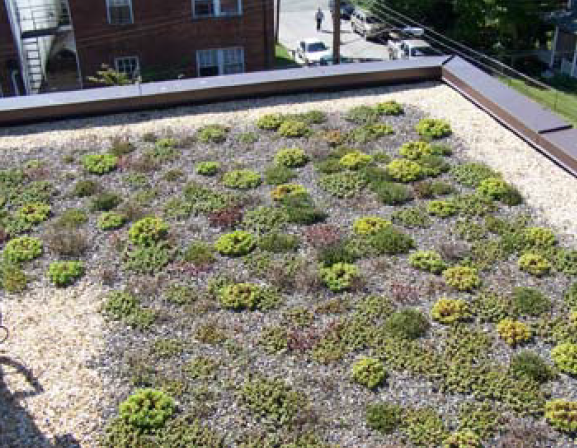
An extensive green roof planted with sedums. Image by Susan Donaldson.
Maintenance
Like a conventional roof, a green roof requires periodic care for optimal performance.
- Inspect the green roof on a regular basis for leaks and proper drainage. Current technology for waterproofing is greatly improved, and lowcost electronic grids can be installed under the membrane to locate leaks.
- If used, monitor the irrigation system and adjust to plant water demands. Cycle irrigation on and off to avoid runoff. Irrigation may also be needed to decrease wildfire risk during the dry season.
- Keep drainage pipes and other drainage features clear of debris.
- Remove or mow dead plant material and weeds.
- Add mulch periodically
- Replace vegetation as needed.
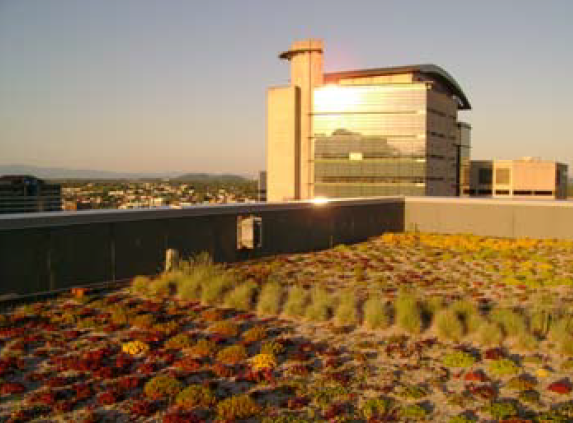
An extensive green roof on the Portland Building in Portland, Oregon. The plants chosen offer a variety of colors. Image by Portland Bureau of Environmental Services.
LID is used because it is:
- EFFECTIVE in reducing and treating urban runoff
- ECONOMICAL, when less infrastructure is required for LID practices than for traditional stormwater features
- SIMPLE! Most LID features are not highly engineered, expensive or elaborate
- FLEXIBLE and customized for each site
- USEFUL in achieving multiple objectives: stormwater management, landscape beautification, habitat improvement, open space connectivity, etc.
- DESIRABLE, because it adds value when the landscape features used to achieve LID goals are also aesthetically pleasing. This can increase property values.
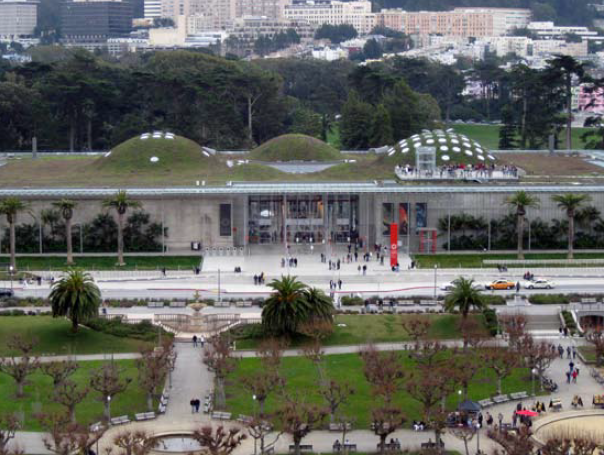
This green roof in San Francisco provides a way to capture and infiltrate rainwater, reduce stormwater runoff and augment valuable green space. Image by Susan Donaldson.
For additional detailed planning and design information
refer to the latest versions of the Truckee Meadows Low Impact Development Handbook and the Truckee Meadows Structural Controls Design Manual available at www.tmstormwater.com.
Additional information about green roofs can be found at:
- Green Roofs for Healthy Cities, GRHC
- Michigan State University, Department of Horticulture, Green Roof Research Project, MSU
- Portland Bureau of Environmental Services, EcoRoof, City of Portland
- Urban Design Tools, Low Impact Development, Green Roofs, LID
- U. S. Environmental Protection Agency, Heat Island Mitigations, Green Roofs, EPA
Technical review provided by Chris Conway, Certified Professional in Sediment and Erosion Control.
Donaldson, S.
2009,
Low Impact Development in Northern Nevada: Green Roofs,
Extension | University of Nevada, Reno, FS-09-27


